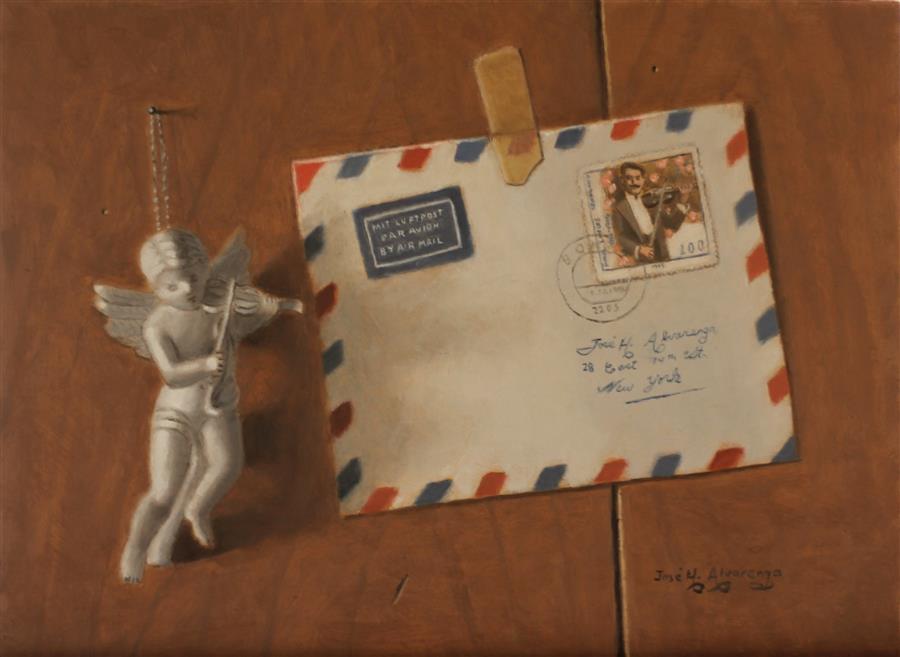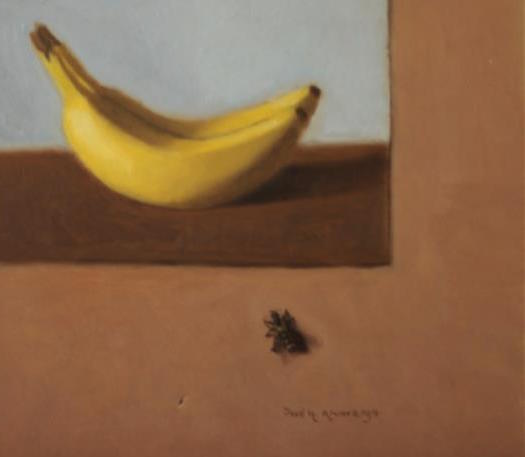Artist Of The Week: Jose H. Alvarenga, Ce N'est Pas Une Banane
Ce n’est pas une banane. This is not a banana. This is not even a painting of a banana. It is a painting of a painting of a banana – and, it is very threatening.
The Treachery of Images by René Magritte
Chrome Yellow by Jose H. Alvarenga reenters the tautological conundrum posited by René Magritte in the late 1920’s in his painting The Treachery of Images. Magritte’s painting shows a pipe and the French caption “Ceci n’est pas une pipe,” which translates to “this is not a pipe,” it is instead a representation of a pipe. Both Chrome Yellow and The Treachery of Images are self-referential paintings point to the paradoxes that structure the world: symbols.
Symbols have a great deal of responsibility, and questioning their authority is a dangerous business. Symbols are the currency of value and meaning. Without them there would be no money, language, art, games, souvenirs, nicknames or anything else Jose H. Alvarenga might be interested in painting. Symbols are the subject of Jose’s portfolio. And each of his still life paintings subverts the very systems that construct our entire civilization.
This is a big task for a bunch of bananas. Outside the perimeters of the Yellow Chrome canvas, there are certain challenges to taking bananas seriously. The fruit is encumbered with the role as the archetypal gag of slapstick comedy and the possessor of an objectively funny name. Nevertheless, Jose recasts bananas as the Magritte-style symbol of symbols. Jose uses other objects to point to the treachery of the image of a banana. On the left side of the canvas, he presents a tube of yellow chrome paint gesturing to the banana’s status as art. Below the canvas, he paints an insect. The viewer wonders if the bug will be attracted to the fruit. However, their modes of communication are ironic and mismatched. The rental world is unsupported by the antenna. While the painting of a banana communicates visually, the insect perceives chemically. If the symbol is expressed in a different language, then ce n’est pas une banane.
Jose reiterates the incompatibility of different symbol systems, but complicates them with subtle similarities. In Violin Concerto, an angel-winged cherub and a postage stamp bearing the likeness of German composer Paul Lincke link up for the world’s unlikeliest duet. Despite the cherub’s non-existent relationship with the nonfictional world and the composer’s concluded relationship with life (Paul Lincke died on September 3, 1946), their two horsehair bows form a perfect parallel relationship; geometrically, orchestrally, and visually, they are in concert.
An annotated version of the oil painting Violin Concerto by Jose H. Alvarenga which demonstrates the parallel lines formed between the two violin bows.
Were this not masterminded by Jose H. Alvarenga, their “concert” would have roughly the same intentionality as that of a turn signal clicking to the beat of a car radio. Like the insect and the chrome yellow banana, they come from two separate value systems. Linke is a historic figure; a cherub is a mythological figure. A stamp has a clear function and articulated value; a cherub has a less clear function and value. And finally, while stamps are strictly two dimensional, cherubs – which, as we all know, are the quintessence of plumpness– are characterized by their rotund third dimension. Despite these differences, Jose finds a relationship between them through a common interest in the violin and the parallel line between their bows.
Once again, Jose juxtaposes objects from unrelated and seemingly incompatible realms. The objects congregate like consecutive dictionary entries – no matter how distant their origins and meanings are, they have one similarity that keeps them together forever. A cherub and postage stamp have as much in common as a tube of mascara and a mascot, and yet, the shared angle of a violin bow—like a shared first syllable– links the two entities. Suddenly, they can be compared.
Jose paints in a hyper-realistic and clear style, without which, the viewer would have limited access to his complex commentary. His paradoxical parallels are disguised by a nonchalant exterior in austere interiors. Every one of Jose’s compositions follows the same basic formula: neutral-toned walls and/or shelving, a buffer of negative space, and one to three objects. Though they are symbolic and complex, the objects come from the ordinary world; they include gift shop novelties, endangered technology, hobby kits, and household knickknacks.
Jose does not rummage through a junk-drawer haphazardly; all the objects represent abstract ideas beyond the canvas. These value systems include money (as in, the peso in Mexico’s Souvenirs, the coin in Money Is The King, and the stamp value in Violin Concerto), games (as in, the cowboy figurines in Duel! and the playing cards in Joker and Money Is The King), art (as in, the artwork in Chrome Yellow, Traditional Ways, Duel!, and Windmills), souvenirs of travel (as in, the tequila bottle in Mexico’s Souvenirs and the figurine in Windmills) and language (as in Pewter Train, Joker, and Violin Concerto). Jose points to a standardized dependency on symbolism that is rampant in our material culture. The symbols ask the viewer to accept them as currency for value, meanings, and ideas that go beyond their immediate, material makeup.
The sparseness of the setups cultivates a sense of transience. The ways in which the objects are fastened to the background (i.e., masking tape and small nails) compulsively resist long-term commitment. It is as if the dweller of this neutral-toned abode had one goal in mind for a décor style: security deposit reclamation. Even the most extreme disturbances to the walls could be repaired with a pea-sized glob of spackle. This makes it easy to envision the world without symbols: austere, neutral, and literal. The objects materialize their status as symbols by resisting their immediate environments; their full meaning is not fully present.
Are we all not like the bug Chrome Yellow, constantly being asked to buy into symbols? Are the world's symbols actually fruitful or are they all just bananas? When Jose H. Alvarenga presents you with a painting, you have a choice: to perceive the deeper meanings or just see flat surfaces. But, if you don’t enter the world of these symbols, are you just a fly on the wall?
Detail of Chrome Yellow









